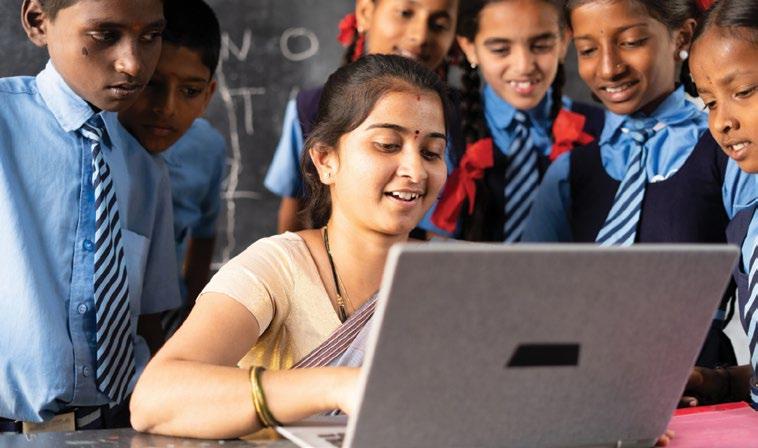
4 minute read
Understanding the India Stack…
The last decade has seen India change exponentially. Besides the economics and the demographics, there are a series of various events which has brought these changes in the country. We are also in the clear focus of the world and there is no global expansion for any company of large ambitions, to miss out on India. While there are various indicators that have enthralled the world, there is none more than the digital tools introduced, which amount to more amazement. The armory of these tools has given a different flavor to commerce and the results are phenomenal strides in every walk of life. Together these digital enablers are called the India Stack.
If one can take a deep dive into the stack, the name that chimes everywhere is Nandan Nilekani. Nandan is definitely among the most outstanding pillars of the Indian technology foundation, both in the private and public sectors. He was a co-founder of Infosys, one of the world's largest information technology services firms with a market cap of over $75 billion, and served as the Chairman of UIDAI, which developed many of India's worldclass public digital infrastructure initiatives. The forays into Aadhaar, UPI, OCEN, amongst others created what we put in a ‘pride of place' story and the world looks on with respect and envy – the unique capability of having build tools at the population scale.
Advertisement
There were primarily two reasons how the entire process started. The first was India was increasing its welfare programs and distributing things like pensions, scholarships, unemployment, insurance and so on. The challenge had always been to identify the beneficiaries and also how to authenticate whether the right person is getting the endowment of the government. We needed something like the social security scheme in the US, the ability to identify every individual in the country and authenticate. The second reason was that Indians were transitioning into a migrant society. People were travelling for livelihoods across the length and breadth of the country and outside the country. While foreign travel had structured regulations, we lacked the means of identification in the domestic circuit. Regular identification tools like the birth certificate, and schools records was non existent for vast tracts of the population. With larger economic development, people were travelling everywhere and it became imperative to have an identification. Both these factors the inclusion need for getting millions of people with identification as well as the fiscal need of making sure that benefits were more efficient led to the genesis of the need for a unique
ID. This was approved by the Indian cabinet in January 2009. And Aadhar was born!
The ID was designed as a digital ID, which means you can do authentication of the ID online and verify it for multiple purposes. The same ID could be used for KYC, or know your customer, which is an electronic know your customer. And with this, it was of immense use to the regulators, it could be used to open a bank account or to get a mobile connection or any transaction that required trust verification.
Then the idea of a digital locker came up, which allowed people to store their documents on the cloud. And today, the DigiLocker of India has 125 million people who store their ID cards or their vaccination certificates or their driver's license. So basically, the ID with its authentication, KYC, digital signature, and digital locker was one comprehensive suite of programs, which came out. These could be effectively used for the direct benefit transfers of the central government.
During this time, the project of creating a peer-to-peer payment system was envisaged. NPCI (National Payments Corporation of Inda) in May of 2016 launched a payment platform called UPI (Unified Payments Interface), which was an interoperable peer-to-peer, four-party payment system. What we mean by saying it's four-party is that you could be using a private service like Google Pay and having a bank account in HDFC, and one could be using PhonePe and having a different bank account in a different bank in Punjab National Bank, and we could interoperate and send money in real-time, so any bank account using any consumer app to any other consumer app. This is a unique innovation that's not been done anywhere in the world. This system rolled out 100,000 transactions by October 2016. When demonetization happened and the withdrawal of certain currency notes happened. the need to have digital payments became very, very important. And the government embraced and endorsed UPI. They launched an app called BHIM on UPI, which the Prime Minister launched in December 2016. And then other people came on the platform like PhonePe, Paytm, Google Pay and so on. Today, about 275 million people are using it for payments. This amounts to close to 7 Billion transactions of billions of dollars!

Then came the Goods and Sales Tax (GST) system. India has an excellent indirect tax system, which is nationally rolled out on the GST, which is again completely digital. There are about 11 million businesses on GST. They all file their returns electronically. And they all submit their invoices electronically to the GST because you get the invoices through the matching of tax credits on GST, which is a valueadded tax system. The system enables great information collateral at work where people get access to credit through this. So suddenly, a whole class of small businesses that was historically starved of credit will now get access to credit, which is a great thing. But the macroeconomic benefit of this is if 10 million businesses get access to credit, and with that, they're able to grow their business.
Once you get access to credit, then the supply chain will get dis- intermediated or basically get loosened up because as you said, today, the supply chain is both a lender of money as well as a provider of products. And then the other thing which is happening is ONDC (Open Network for Digital Commerce), which is disaggregating commerce and creates an open commerce network. This will ease the access and supply chain for even the smaller business players and create a more vibrant platform for commerce.
Together each of these creates the India Stack. Aadhaar Stack provides one layer, UPI provides one layer, economic and empowerment provides another layer, and ONDC provides another layer. They provide the interoperability and the flexibility to bring most aspects of the business together! These unique public digital goods will enable the current count of 90,000 start-ups, all rearing to go, who will then use these digital capabilities and create products and services that create value for themselves and their investors and create value for the consumers

Dr Arun Oommen MBBS, MS (Gen Surg), MCh (Neurosurgery), MRCSEd,MBA Senior Consultant Neurosurgeon VPS Lakeshore Hospital
NH-47, Bypass, Maradu, Nettoor PO, Kochi 682040, India.
The majority of brain tumours don't have any specific causative factors. The best-known environmental risk factor for brain tumors is radiation exposure.









